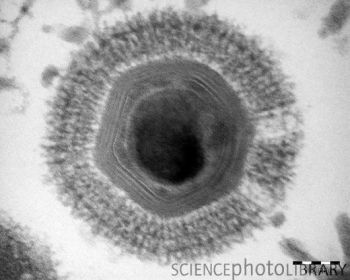
mimivirus的TEM电镜照片
Megavirus的发现证实,大型病毒是源于变得较为简单的复合细胞(complex cells)。
自从2003年第一次发现大型病毒mimivirus,研究者们就在争论它们是如何进化的。与传统的病毒不同,mimivirus携带许多原本认为只有细胞生命才具有的基因,这就意味着它是从细胞进化来的。不过,这些基因也有可能是从其感染的细胞中“窃取”来的。
新发现的大病毒,绰号megavirus,它比mimivirus大6.5%。由法国马赛结构与遗传信息实验室的Jean-Michel Claverie在智利海岸采样的海水中发现。作为mimivirus的远亲,它拥有mimivirus所有的类似细胞基因。
Claverie说这是大病毒源于细胞祖先的“有力证据”。(生物探索 william)
相关英文论文摘要:
Distant Mimivirus relative with a larger genome highlights the fundamental features of Megaviridae
Mimivirus, a DNA virus infecting acanthamoeba, was for a long time the largest known virus both in terms of particle size and gene content. Its genome encodes 979 proteins, including the first four aminoacyl tRNA synthetases (ArgRS, CysRS, MetRS, and TyrRS) ever found outside of cellular organisms. The discovery that Mimivirus encoded trademark cellular functions prompted a wealth of theoretical studies revisiting the concept of virus and associated large DNA viruses with the emergence of early eukaryotes. However, the evolutionary significance of these unique features remained impossible to assess in absence of a Mimivirus relative exhibiting a suitable evolutionary divergence. Here, we present Megavirus chilensis, a giant virus isolated off the coast of Chile, but capable of replicating in fresh water acanthamoeba. Its 1,259,197-bp genome is the largest viral genome fully sequenced so far. It encodes 1,120 putative proteins, of which 258 (23%) have no Mimivirus homologs. The 594 Megavirus/Mimivirus orthologs share an average of 50% of identical residues. Despite this divergence, Megavirus retained all of the genomic features characteristic of Mimivirus, including its cellular-like genes. Moreover, Megavirus exhibits three additional aminoacyl-tRNA synthetase genes (IleRS, TrpRS, and AsnRS) adding strong support to the previous suggestion that the Mimivirus/Megavirus lineage evolved from an ancestral cellular genome by reductive evolution. The main differences in gene content between Mimivirus and Megavirus genomes are due to (i) lineages specific gains or losses of genes, (ii) lineage specific gene family expansion or deletion, and (iii) the insertion/migration of mobile elements (intron, intein).







